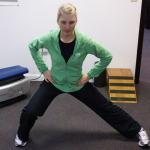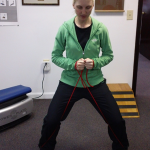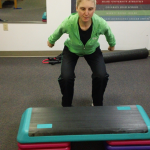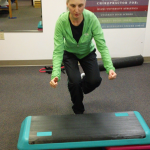Basketball exercises:
6 exercises to boost your vertical leap:
- Drop squats
- Off box stabilization
- Squat jump with counter movement
- Box blast with counter movement
- Squat jump with counter improvement
- Drop squats to jump and stabilize
How to improve lateral speed for basketball
You may be able to run up and down the court in flash, but how well do you move side-to-side? Your lateral speed is one of the most important factors when playing defense. There is a lot of acceleration and deceleration needed, so it is important to loosen up your hips and groin.
How do I improve hamstring flexibility?
This is a question I receive on a daily basis. Muscles often tighten up because your body is trying to create stability where it is lacking. For instance, you might think your hamstrings are tight, but the underlying issue could be an unstable core. So if you simply improve the flexibility of the tight muscle, you may actually be removing your body’s point of stability. As a result, your body can become more unstable, increasing your risk of injury. If you’ve been stretching your hamstring for years, and they are still tight, it is not a hamstring issue. Try these exercises instead.
- Lateral Squat
- X Walk
- Drop Lunges
ACL Injury prevention
ACL injuries are becoming ridiculously common among athletes from the junior high/high school levels on through the professional levels of all sports. My personal thoughts on this issue are that they are a result of the poor training programs most of these kids go through.
The act of jumping and leaving the floor is not so much the problem. But what goes up, must come down, and it’s not always pretty when it does. Landing incorrectly, with the knees in an abnormal formation, is a major cause of ACL injuries.
Landing efficiently involves all the following: Landing on the balls of the feet; knees aligned with the mid to outer foot; hips are back absorbing force; slight forward lean of the trunk with the back flat. Basically it is a good squat position!
So when addressing ACL prevention, start with squat progression exercises and progress into landing progression exercises with single and double legs.
The importance of ankle mobility!
One of the issues we’re seeing, in both athletes and in our general population, is a lack of ankle mobility -more specifically dorsiflexion of the ankle. For just about everything in life, from sprinting to squatting, we need a certain amount of dorsiflexion of the ankle. If we don’t have it, we have to compensate.
The most common things we see in patients with a lack of dorsiflexion is an “out toeing” as this opens up the ankle and allows for them to get to where they need to be, even if it is not the most biomechanically correct way to do so. This out-toeing may also be caused by a internal rotation deficit in the hip. An example of compensation due to lack of dorsiflexion is a baseball pitcher who pushes through the toe instead of the heel, creating a quad-dominant propulsion in a scenario that should have significant contribution from the posterior chain musculature.
A lack of ankle mobility may also negatively affect knee function. Lack of motion can increase rotational torque at the knee. If you lock up a joint that should be mobile, the body will look elsewhere to create that range of motion.
Alleviating ailing ankles!
Sports are extremely stressful to the body and the ankle joint is no exception.
Over the course of an athletic practice or competition, each foot contacts the ground hundreds, or even thousands, of times and goes into plantar flexion for propulsion just as many times. This repetitive strain can shorten the plantar flexors, and over time, this jarring of the joint causes natural gliding to become restricted. Add to this mix, the ankle is the most commonly injured joint in sports. The loss of dorsiflexion creates an inability to actively dissipate force in the lower extremity and can lead to problems both in the ankle and up the leg, as the force must go somewhere.
Furthermore, lower ankle dorsiflexion can lead to a bouncy appearance in the gait because the body’s weight is transferred to the forefoot too soon, leading to inefficient locomotion. As this can be caused by joint-mobility restrictions, muscular tightness, or a combination of both, achieving proper dorsiflexion should be addressed with a multifaceted corrective approach, including tissue lengthening, joint mobility, and lifestyle modifications. Muscular tightness should be addressed first with techniques of foam roller and stick work for muscular lengthening.
The ankle and foot is an extremely complex system that makes effective locomotion possible. There are practical strategies that can help optimize this performance in sports and in life.
Ankle mobility and dorsiflexion can be achieved with the following exercise of ankle mobility with tibial glide as shown below.
Jumping Exercises
- Box Jump
- Single Leg Box Jump





